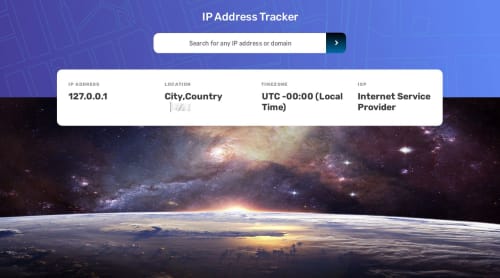Responsive Mob\Desk with Vanilla Html,Css,Js,NodeJS using API`s.

Solution retrospective
Firstly A big BIG Thank you once again to FrontEndMentor.io for this Challenge, and
a hello to all the passionate developers out there. Well it has been a long journey for me on this one where i have been trying to find the right APIs which have not been easy but i have at last managed to work around the issues.
With being eager to get to know NodeJS i have setup a backend NodeJS "serverless" server on glitch.com to... 1: Hide\Protect API Keys, 2: Serve Maps, 3:Provide IP addresss via dns.resolve. On the 3rd point i did try and find what APIs were out there but all of them required a payment or a very limited number of clicks for testing etc.. So i decided to do this bit in the end via the nodeJs Server itself using dns.resolve . For APIs i used 1: "ipgeolocation.io" - for IP address Details. 2:"https://api.bigdatacloud.net" - retrieving public ip address. 3: "https://developer.here.com/documentation/examples/rest/map-image" - for retrieving and serving the map on nodeJS via the coordinates sent from "ipgeolocation.io". I hope that makes sense 😅. One thing i did wonder about was deciding what to do when a list of more than one ip addresses was provided from a domain like Yahoo.com. Here i decided to use the notification to list all the ips provided that the user can copy and advise the user that will use the first ip in the list.
I am more than happy to walk through with anyone interested on how i put it all together to help others learn, with me on this learning journey as well in the world of Web Development.
All the Best, M.
Please log in to post a comment
Log in with GitHubCommunity feedback
No feedback yet. Be the first to give feedback on GHNetCode's solution.
Join our Discord community
Join thousands of Frontend Mentor community members taking the challenges, sharing resources, helping each other, and chatting about all things front-end!
Join our Discord